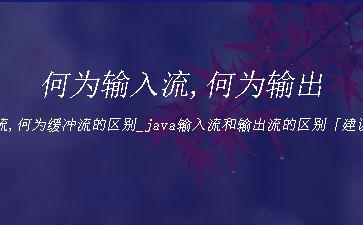在沈阳华清远见的学习之输入输出流~
前言
流(Stream)是指在计算机的输入输出操作中各部件之间的数据流动。按照数据的传输方向,流可分为输入流与输出流,它是java中比较重要的知识点,无论是面试考试,还是实际工作中,这都是经常能够看到的身影,所以今天我写下这篇文章,希望各位看官可以更好地了解流的相关知识。
1、输入流
1.1字节输入流(InputStream)
字节流处理单元为1个字节,操作字节和字节数组。
package com.hqyj.test;
import java.io.File;
import java.io.FileInputStream;
import java.io.FileNotFoundException;
import java.io.IOException;
public class Test {
public static void main(String[] args) throws IOException {
File file = new File("文件地址");
if (file.exists()) {
FileInputStream fis = null;//判断文件是否存在
try {
// 创建一个文件字节流进行对文件读取
fis = new FileInputStream(file);
// 创建字节数组作为传递载体
byte b[] = new byte[1024];
// 判断每次读取到的内容数量,不为-1则说明还有内容
int length = 0;
// 创建一个字符串对象来承载读取到的内容
StringBuffer str = new StringBuffer();
// 循环读取,数量为-1则说明读取完成
while ((length = fis.read(b)) != -1) {
// 将每次读取到的内容制作成字符串,拼接在原字符串的后面
str.append(new String(b, 0, length));
}
// 显示字符串
System.out.println(str);
} catch (FileNotFoundException e) {
e.printStackTrace();
} finally {
// 关流
fis.close();
}
} else {
System.out.println("文件不存在");
}
}
}
1.2字符输入流(Reader)
字符流处理的单元为2个字节的Unicode字符,分别操作字符、字符数组或字符串,字符流是由Java虚拟机将字节转化为2个字节的Unicode字符为单位的字符而成的,所以它对多国语言支持性比较好。
package com.hqyj.test;
import java.io.File;
import java.io.FileReader;
import java.io.FileNotFoundException;
import java.io.IOException;
public class Test {
public static void main(String[] args) throws IOException {
File file = new File("文件地址");
if (file.exists()) {
FileReader fr = null;//判断文件是否存在
try {
// 创建一个文件字节流进行对文件读取
fr = new FileReader(file);
// 创建字节数组作为传递载体
char[] c= new char[1024];
// 判断每次读取到的内容数量,不为-1则说明还有内容
int length = 0;
// 创建一个字符串对象来承载读取到的内容
StringBuffer str = new StringBuffer();
// 循环读取,数量为-1则说明读取完成
while ((length = fr.read(c)) != -1) {
// 将每次读取到的内容制作成字符串,拼接在原字符串的后面
str.append(new String(c, 0, length));
}
// 显示字符串
System.out.println(str);
} catch (FileNotFoundException e) {
e.printStackTrace();
} finally {
// 关流
fr.close();
}
} else {
System.out.println("文件不存在");
}
}
}
2、输出流
2.1字节输出流(OutputStream)
package com.hqyj.test;
import java.io.File;
import java.io.FileNotFoundException;
import java.io.FileOutputStream;
import java.io.IOException;
import java.util.Scanner;
public class Test2 {
public static void main(String[] args) throws IOException {
Scanner scan = new Scanner(System.in);
String str = scan.next();
File file = new File("文件地址");
if (file.exists()) {
FileOutputStream fos = null;
try {
fos = new FileOutputStream(file,true);
fos.write(str.getBytes());
} catch (FileNotFoundException e) {
e.printStackTrace();
} finally {
fos.close();
}
} else {
System.out.println("文件不存在");
}
}
}
2.2字符输出流(Writer)
package com.hqyj.test;
import java.io.File;
import java.io.FileNotFoundException;
import java.io.FileWriter;
import java.io.IOException;
import java.util.Scanner;
public class Test2 {
public static void main(String[] args) throws IOException {
Scanner scan = new Scanner(System.in);
String str = scan.next();
File file = new File("文件地址");
if (file.exists()) {
FileWriter fw = null;
try {
fw = new FileWriter(file,true);
fw.write(str.getBytes());
} catch (FileNotFoundException e) {
e.printStackTrace();
} finally {
fw.close();
}
} else {
System.out.println("文件不存在");
}
}
}3、文件复制
首先要提到的是字节流与字符流的区别:
(1)字符流处理的单元为2个字节的Unicode字符,分别操作字符、字符数组或字符串,而字节流处理单元为1个字节,操作字节和字节数组。
(2)字符流是由Java虚拟机将字节转化为2个字节的Unicode字符为单位的字符而成的,所以它对多国语言支持性比较好
(3)如果是音频文件、图片、歌曲,就用字节流好点,如果是关系到中文(文本)的,用字符流好点
(4)所有文件的储存是都是字节(byte)的储存,在磁盘上保留的并不是文件的字符而是先把字符编码成字节,再储存这些字节到磁盘。在读取文件(特别是文本文件)时,也是一个字节一个字节地读取以形成字节序列
说完了输入流与输出流,接下来就是他们的应用啦,最经典的例子就是文件复制的问题,这里用字节流举例
package com.hqyj.test;
import java.io.File;
import java.io.FileInputStream;
import java.io.FileNotFoundException;
import java.io.FileOutputStream;
import java.io.IOException;
public class Test2 {
public static void main(String[] args) throws IOException {
File file = new File("文件1地址");
File file1 = new File("文件2地址");
FileInputStream fis = null;
FileOutputStream fos = null;
fis = new FileInputStream(file);
fos = new FileOutputStream(file1);
byte b[] = new byte[1024];
int length = 0;
while ((length = fis.read(b)) != -1) {
fos.write(b);
}
fis.close();
fos.close();
}
}
4、缓冲流
字节流:BufferedInputStream,BufferedOutputStream
字符流:BufferedReader,BufferedWritter
缓冲流是一个特别的流,缓冲流的基本原理是创建流对象时候,会创建一个内置的默认大小的缓冲区数组,通过缓冲区书写,他的作用是提高系统读写速度,这里用上面的文件复制加缓冲流进行举例
package com.hqyj.test;
import java.io.BufferedInputStream;
import java.io.BufferedOutputStream;
import java.io.File;
import java.io.FileInputStream;
import java.io.FileOutputStream;
import java.io.IOException;
public class Test3 {
public static void main(String[] args) throws IOException {
FileInputStream fis = new FileInputStream(
new File("文件1地址"));
FileOutputStream fos = new FileOutputStream(
new File("文件2地址"));
BufferedInputStream bis = new BufferedInputStream(fis);
BufferedOutputStream bos = new BufferedOutputStream(fos);
byte[] bytes = new byte[1024];
while (bis.read(bytes) != -1) {
bos.write(bytes);
}
bos.flush();
bis.close();
bos.close();
fis.close();
fos.close();
}
}
缓冲流减少了CPU通过内存访问磁盘的次数,极大的提高了读写的速度和效率,IO流操作文件内容都是在缓冲流内部的缓冲数组之中的。
总结
以上就是今天要讲的内容,何为输入流,何为输出流,何为字节流,他们的作用是什么,怎么使用,有什么优缺点,希望对各位读者能有所帮助。
今天的文章何为输入流,何为输出流,何为缓冲流的区别_java输入流和输出流的区别「建议收藏」分享到此就结束了,感谢您的阅读。
版权声明:本文内容由互联网用户自发贡献,该文观点仅代表作者本人。本站仅提供信息存储空间服务,不拥有所有权,不承担相关法律责任。如发现本站有涉嫌侵权/违法违规的内容, 请发送邮件至 举报,一经查实,本站将立刻删除。
如需转载请保留出处:http://bianchenghao.cn/75948.html

